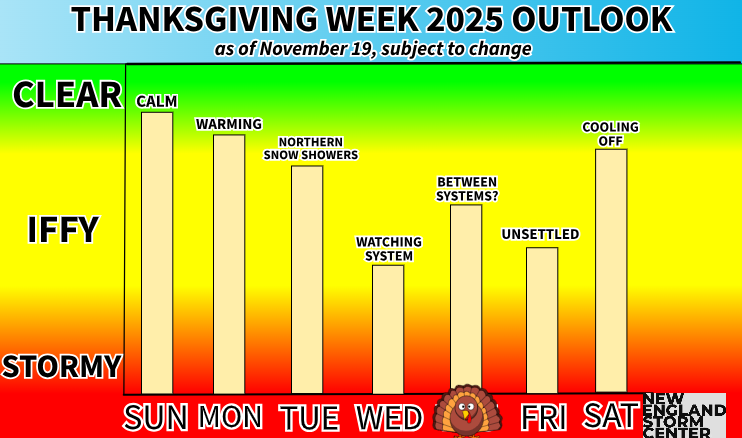Heat Kicks in for New England with Strong Thunderstorms Possible
- Tim Dennis
- Jun 19
- 4 min read
Thursday will be very summer-like with two warm season features incoming: heat and thunderstorms. Both of these will be set up by a rather strong frontal system first lifting a warm front across the region followed by a cold front late in the day. This will set the stage for both heat index values well into the 90s in spots as well as the potential for strong to severe thunderstorms.

New England will remain in the warm sector on Thursday, with conditions more favorable for higher heat and humidity compared to today. Temperatures aloft will peak, allowing for the hottest day of the week. Widespread highs in the 80s to near 90° are possible for southern and central New England. With dew points well into the 60s to near 70°, feels-like temperatures will be well into the 90s for much of southern New England). The northern tier will be kept a notch cooler, but widespread highs in the 80s are likely just about everywhere.

Thursday's frontal system will also likely trigger a line of scattered thunderstorms in the afternoon and into the evening. This line will come ahead of the system's cold front, expected to cross the region later Thursday into the overnight hours. While this cold front will provide the main source for storms to develop, pre-frontal storms will be possible earlier in the afternoon given the setup.
The western half of New England will have the best chance of seeing storms erupt in the afternoon. The ingredients for strong to severe thunderstorms will be in place. Likewise, western New England will have the highest chance for severe weather as well. How far east the main line of storms can push in the late afternoon and evening before weakening remains the biggest question. The main storm threat will likely be in the 3pm-7pm range for western New England and the 5pm-9pm range for eastern New England.

Strong to damaging winds gusts will be the greatest threat within storms as strong winds in the upper-levels will be present. Downdrafts within the storms will help bring these winds down to the surface. Both large hail and brief tornadoes are secondary threats. While conditions aren't really primed for large hail development, ample wind shear is present.
With linear storm motions and elevated winds shears, it's possible New England sees its first tornado of the season, but this remains a low threat overall. The atmosphere is highly moisture-rich, with PWATS (a measure of moisture in the atmosphere). in the 1.5-2" range. PWATS this high definitely supports downpours and localized flooding, however, quick storm motions should limit this overall threat.

Taking a look at the main ingredients for severe storms, all four will be in place. Wind shear will be on the order of 35-55mph, with the strongest values located across western New England (mainly west of the Connecticut River). This is ample shear to allow storms to strengthen, and rather quickly. Moisture will be very high, with dew points well into the 60s, toward 70° within the warm sector. The warm sector will be supportive of a moderately to strongly unstable atmosphere, with 1,500 to 2,500+ joules/kilogram of CAPE.
Below: NAM showing CAPE values (Convective Available Potential Energy, a measure of instability) Thursday afternoon:

The biggest limiting factor (and it may be a significant limiting factor; if storms end up few and far between, this is to blame) is the late timing of the cold front. This front will be the main source of lift, and will likely not cross New England until late in the day, most likely in the evening into the overnight hours.
This is why the best chance for severe storms will be across Vermont, western Massachusetts and western Connecticut with chances steadily dwindling moving eastward. Some areas in southern New Hampshire, eastern Massachusetts, Maine and Rhode Island may not see much of any storm activity until very late in the day. There remains variability among guidance on how much pre-frontal activity can develop earlier in the afternoon, before the front arrives.
Below: FV3 showing potential weather around mid-afternoon today:

This late timing of the cold front is the main reason why a full-on severe weather outbreak is not favored despite favorable conditions. Scattered severe storms are likely, but plenty of areas across New England will likely see little to no activity as well. Any pre-frontal storm activity that manages to form in the afternoon before the cold front arrives will likely become strong to severe quickly. Overall trends have seen the chances of pre-frontal activity go up over the last 12 hours. This is why the severe threat has been nudged slightly east by the Storm Prediction Center this morning.
Heading into next week, a strong ridge of high pressure looks to become centered to New England's southwest. This ridge is currently advertised with a height of 590-594 decameters extending into New England (the higher the decameters, the stronger the ridge and therefore, the higher the temperature potential), which would support highs well into the 90s in late June for New England's typical hot spots (mainly the river valleys).



Comments